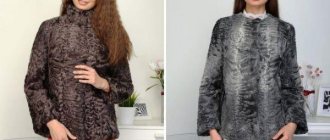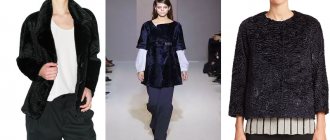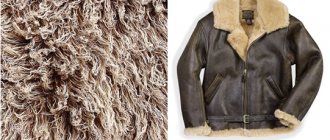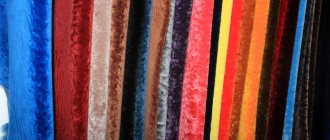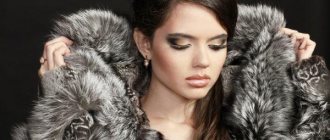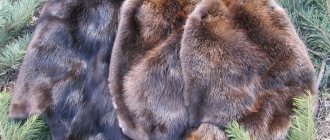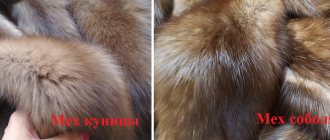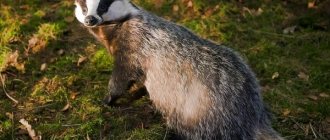Europe began to value Russian furs much earlier than our country realized their value. And if in the Middle Ages our ancestors traded mainly in furs, later sheep skins were added to the goods. And in the 20th century, karakul, a unique type of fur representing the skins of lambs, became especially widespread.
Despite the fact that it was known several centuries ago, it was the last century that became the golden age of the popularity of astrakhan fur, astrakhan fur. Many people believe that these are two different names for the same fur. But there are clear differences between them.
What is the difference between astrakhan fur and astrakhan fur?
What comes to mind when you imagine smooth black fur consisting of small curls? Most likely, a hat or fur coat made from astrakhan fur. In Soviet times, pie-shaped astrakhan hats were in great demand among middle and senior officials. Every resident of the USSR dreamed of having an astrakhan fur coat in her wardrobe. One should not think that today this fur is not successful. It's still popular. But not every modern fashionista knows what astrakhan fur is, what is the difference between it and astrakhan fur.
Karakul - skins of Karakul lambs aged 1-3 days. Karakulcha is the same skins of lambs, but not born.
These two types of sheepskin fur have other differences, namely:
- appearance;
- degree of heat;
- strength level;
- usage.
The original origin of karakul is Uzbekistan. This breed of sheep was bred there; they received their name in honor of the oasis of the same name on the Zeravshan River. There is no need to think that the homeland of this fur is the Caucasus. Astrakhan fur and broadtail differ, first of all, in appearance. In the first case, the fur is dense, the curls are pronounced and fully formed. Thanks to them, the surface has a unique texture.
The broadtail is distinguished by a unique pattern (the so-called moire), since its curls have not formed. The skins have a thin inner layer, and in addition, for obvious reasons, they are much smaller in size. Astrakhan fur feels much silkier than astrakhan fur, and its color is also black. But you can find golden or silver shades, which are especially appreciated by consumers.
Astrakhan fur retains heat better. It is dense, so you can easily stay in the cold for a long time in a jacket made of astrakhan fur. His curls are not afraid of moisture either. There are no curls in astrakhan fur, the density is lower, and products made from it are not suitable for wearing in winter.
The flesh of astrakhan skins cannot be called durable, but astrakhan fur is still superior to astrakhan fur. It is considered one of the most durable types of fur: clothing can easily withstand 10 seasons. In contrast, broadtail is not resistant to wear.
A fur coat made from astrakhan fur will last you no more than three seasons.
Karakul and broadtail
Their texture is unusual, and their stylish style will add charm to your look. Large, random curls of astrakhan fur are a unique effect in the product. These pliable materials have always been loved by both designers and fashionistas. Among the variety of this fur, you can choose exactly the one that will be the best for you.
Several types of fur can be obtained from domestic sheep. For example, sheepskin - the fur of an adult sheep - is one of the warmest and most durable. Its wear resistance is 55% of the standard.
Mouton
- also sheep fur, but processed in a certain way. Karakul and broadtail are the skins of lambs, for which the Karakul breed of sheep is used.
Sheep fur, including astrakhan fur and astrakhan fur, is not only beautiful and elegant, it is adapted to external climatic influences better than any other fur. This fur is easy to clean and dye.
Previously, astrakhan fur was worn by women aged 35+. Now this fur is also popular among very young girls.
And so, let’s figure it out - what is astrakhan fur and what is broadtail? Karakul is the skins of newborn lambs - no older than three days. The female carries the cubs for 20-25 weeks, and usually 1 or 2 lambs are born, and some types of sheep are capable of producing 3-4 cubs. In terms of wear resistance, astrakhan fur is not inferior to sheepskin. The natural color of astrakhan fur is black, gray, sometimes silver and gold, and very rarely white. The value of black astrakhan fur is determined by the beauty of the pattern, which is formed by curls of wool. In each skin, intricate lines and curls create unique and fantastic patterns on the surface of the fur.
Gray has less pronounced curls, but it is no less beautiful due to color transitions.
If a gray karakul contains a certain amount of brown hairs, the skins acquire a beautiful lilac hue. This variety is called “guligaz” - “tamarisk flower”.
Rarer colors are brown and white. Brown astrakhan fur is quite rare in its natural form. But there are colors - chocolate, beige, red, cold fawn. One of the most valuable varieties of brown astrakhan fur is “sur”. This variety is interesting because the intensity of the color of the hairs changes along the length - the root has a darker brown tint, and the ends are lighter.
And finally, the rarest color is white. Afghan white astrakhan is highly valued. White swakara has a milky color.
Broadtail
- skins of unborn lambs. The beauty of the skins lies in the moire pattern, the hair is short and silky, the curls are large, almost unformed. Naturally the skins are small in size. But, despite its lower strength compared to astrakhan fur, astrakhan fur is highly valued and in great demand. The cost of astrakhan fur is higher than the cost of astrakhan fur due to its unique beauty and, accordingly, popularity. The color scheme of astrakhan fur is the same as astrakhan fur. Dyed broadtail comes in different colors and of course black. The natural color of broadtail is black, gray, variegated and sur (if the hair at the base is darker and the tips are light, silver or light golden).
Types of karakul are determined mainly depending on the breed of sheep. For example, Karakul is Uzbek, Afghan, and South African.
Uzbek karakul
- the most inexpensive. Its curls are tight, tubular, it is light and thin. The skins are small in size. And all this determines the cost and popularity of the skins.
Afghan karakul
has a ribbed flat curl pattern. The size of the skins is slightly larger than the Uzbek one, astrakhan fur has an extraordinary shine, which gives it a luxurious look. This astrakhan is of very high quality and light, and therefore its cost is significantly higher than the Uzbek one.
South African karakul (swakara)
- Karakul, which is produced in Namibia. Swakara has a flat curl. The skins are simply magnificent. They are light and thin. This is the most expensive scribble.
As you know, sheepskin is denser, stronger and warmer compared to astrakhan fur and astrakhan fur, but an adult sheep does not have such a beautiful curl pattern. What to do? Yes, they really raise Karakul sheep to produce Karakul, but these, we repeat once again, are the skins of lambs that are only 2-3 days old! Even if you are not one of the “green” people or vegetarians, it still somehow makes your soul a little sad. However, a method has been developed for modifying the hair of sheepskin. With special processing, you can get artificial curls that are quite resistant to moisture, and are very similar to astrakhan curls.
Karakul is divided into varieties and groups depending on the breed of sheep, the quality of the hair (silky, shiny), the shape of the curls and their elasticity, and of course depending on the defects.
Karakul, broadtail, smushka, whiting, strap - these are all the skins of lambs of a certain age of various breeds of sheep with primary hair. Karakul and broadtail are obtained from lambs of the Karakul breed, and smushka, whiting and strap are obtained from lambs of fine-fleece, semi-fine-fleece, semi-coarse-wool and coarse-wool sheep.
Karakul of purebred Karakul sheep is silky, dense with various curls. There are several types of curls: roller, mane, bob, ring, half-ring, corkscrew, lasa, polka dot.
Skins of mixed-breed lambs (from coarse-wool and Karakul sheep) - with rough hair. They are slightly silky, glassy-shiny or matte. Skins with varying degrees of curl.
Smushka
– skins of lambs of Smuskov breeds of sheep, aged 2 - 4 days. The fur is soft, slightly shiny or matte, the curls are similar to astrakhan fur, but looser and even braided.
The skins of fine-fleece, semi-fine-wool, semi-coarse-wool and coarse-wool lambs are divided into several types:
Muare
– with low hairline, with a moiré pattern.
Klam
– with low raised hairline, consisting of manes and ridges, with a moiré pattern.
Lambskin
- with soft or slightly rough, glassy-shiny or matte hair, forming curls of various shapes (in skins - mainly on the ridge and rump).
Strap
- soft hair, which consists of curls in the form of rings or polka dots.
Shaking and sak-sak
– soft silky hair, consisting of ring-shaped and corkscrew-shaped curls.
Karakulcha is very popular in modern fashion. The moire pattern with a beautiful shine gives the product an unusual appearance. Delicate and beautiful broadtail fur looks like flowing dense fabric. Fur products are not just floor-length fur coats. These are coats, short fur coats, suits, dresses, capes, scarves, silk-lined shawls and many other luxurious wardrobe items that designers create, perfectly combining astrakhan fur and leather, leaving the silhouette graceful and feminine.
Astrakhan fur and astrakhan fur are highly plastic fur, so not only coats, suits and jackets are made from it, but also bags. Instead of a regular knitted scarf or stole, you can wear a fur scarf made of astrakhan fur. You can wear it untucked, crosswise, fastened with a beautiful brooch, or you can wrap it comfortably around your neck. In any case, if necessary, it can be easily removed.
A fur bolero is a great alternative to fur vests. The bolero can be worn with an elegant cashmere coat or with a suit.
Winter time, whatever it may be - frost, cold, slush, ice, wind - you are not afraid of it, when there are so many opportunities to experiment with such interesting materials as astrakhan fur, broadtail, whiting, webbing and many others...
Features of doodle
The most common karakul skins are black; gray ones are less commonly found on sale. However, color transitions in gray fur are appreciated due to the fact that its curls are not as clearly expressed as on black. Brown has an increased cost. The most expensive is white, silver. This fur has its own name - swakara. Skins of this variety are especially highly valued.
Today, three types of karakul are known. This:
- Uzbek;
- Namibian;
- Afghan.
Astrakhan fur, produced in Namibia, is considered the most valuable. His curls are flat, extremely delicate, reminiscent of broadtail. The cost of such a fur coat (depending on the finishing) can reach up to 1 million rubles. Karakul from Afghanistan has a special shine; clothes made from it look luxurious. The most wearable and popular is Uzbek. It is light, elegant, and its skins are smaller in size than the first two types. Tailoring from Uzbek astrakhan fur is carried out most often - this is largely due to its moderate price.
Types of fur raw materials obtained from the Karakul breed of sheep
Karakul golyak
- skins of embryos, miscarriages and floggings at the age of 3.5-4 months. The skins are small in size, with thin, loose leather tissue, very low hair that barely breaks out of the leather tissue, adjacent, smooth or faint, with a moiré tint. By color you can distinguish black, gray, plain, colored and variegated skins. The tail is wide at the base, tapering towards the end, an S-shaped appendage.
Broadtail
— skins of embryos and miscarriages at the age of 4-4.5 months. Compared to golyak, these are large-sized skins, with thin but dense leather tissue. The hairline is still low, but more developed than that of the golyak, shiny, silky, with a more or less pronounced moire pattern. The shape of the tail is characteristic of Karakul lambs. By color you can distinguish black, gray, sur, plain, colored and variegated skins.
Karakul-karakulcha
— skins of embryos, miscarriages and floggings at the age of 4.5-5 months. The size of the skins is slightly larger than that of broadtail, but smaller than that of normally born lambs. The hairline is raised, but still short, silky, shiny, with underdeveloped astrakhan curls (ridges and manes) mixed with a moiré pattern. The leather fabric is thin but dense. The shape of the tail is characteristic of Karakul lambs. By color you can distinguish black, gray, sur, plain, colored and variegated skins.
Astrakhan
- skins of newborn lambs, slaughtered in the first three days after birth. The skins are covered with dense, elastic hair of varying degrees of silkiness and shine, forming curls of various shapes. The neck is covered with curls, the length of which along the edges of the neck in a straightened state is up to 4 cm in white and light gray skins, and up to 3 cm in other colors. Smooth hair is allowed on the hind legs, below the hock joint. The tail is characteristic of Karakul lambs (wide at the base, narrowed towards the end, with a characteristic S-shaped appendage). Leather fabric of various thicknesses and densities. The skins are distinguished by color: black, gray, dark, plain, colored and variegated.
Yahobab
— skins of grown lambs aged 8-30 days, obtained during the death or forced slaughter of Karakul lambs. They are characterized by overgrown hair of varying degrees of silkiness and shine, with loose curls of various shapes. The length of the hair at the edges of the neck in a straightened state is 3-5 cm. The size of the skins is larger than that of astrakhan fur. The skin tissue is thick and dense. By color there are black, colored, plain and variegated.
Shaking
(Lamb fur skins) - skins of young animals aged 1-6 months, obtained from dead or forcedly slaughtered animals. The coat of the skins is primary, consisting of soft braids that form corkscrew-shaped, less often ring-shaped curls. The skin tissue is thick and dense. The area of the skins is up to 18 dm2, but not less than 400 cm2. Black and white skins are distinguished by color.
Sheepskin coat
- skins of adult sheep with a heterogeneous wool coat of a braided structure, consisting of downy and guard hairs. Dry and dead hair is often observed on these sheepskins. The leather tissue is thick and loose.
I'M WITH. Etkin “Commodity research of fur raw materials and finished products.”
Why you should wear astrakhan clothes
There is constant debate about whether it is worth wearing astrakhan fur. Many of our compatriots still perceive this fur as something “soviet”. They would be quite surprised to learn how in demand karakul is in Western markets. The nuance is that an ignorant person will not always distinguish an artificial scribble from a natural one.
Meanwhile, natural sheepskin fur is unique. If you purchase a fur coat, coat, or jacket made from real astrakhan fur, rest assured that they will serve you for years, and you can rely on their quality. It is especially worth noting the astrakhan hats, which are uniform hats for senior officers, which already speaks of the prestige and functionality of fur. If you decide to choose broadtail, then it is better to create a jacket or demi-season coat from it. Sewing is entrusted to a professional - on astrakhan fur any seam is extremely noticeable.
Karakul is good because it ideally hides figure flaws. Even in a simple fur coat you will look slim and feminine. What can we say about modern models, which are not only created in original styles, but also have fur trim. By the way, astrakhan clothing for men, including jackets and even blazers, look no less stylish.


